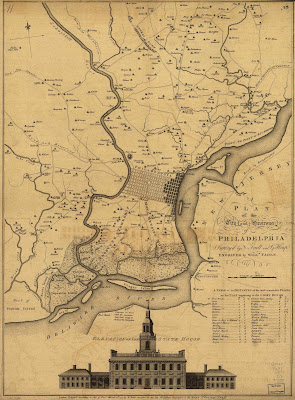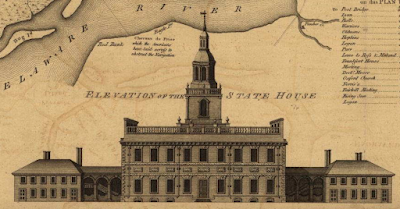People often ask me what my favorite map is. For whatever reason I don't do well with favorites. I don't have a favorite map, or song, book, etc. In attempt to answer I will post three separate maps (possibly more if they come up) that are among my favorites over the next few weeks. The order of these map does not reflect preference. If anything they will be ordered from closest to farthest away.
The first map is the one that appears in the header image of this blog. It also appears on my dining room wall. I've discussed this map before in public so some of you have heard my spiel before - sorry in advance for repeating myself.
A PLAN OF THE CITY AND ENVIRONS OF PHILADELPHIA. Surveyed by N. Scull and G. Heap. Engraved by Willm. Faden 1777
Having spent much of my childhood in Philadelphia, this map resonates with me. I like looking at very urban areas I know fairly intimately and seeing them as farms or quaint villages. I realize they were probably not as quaint as they look on the map but it's fun to entertain that fantasy. There are many nice details such as...
The quaint, industrial village of Frankford, now sitting under an elevated subway line. A similar map is shown on a mural underneath the tracks as highlighted in a previous post. As seen throughout the map, homesteads are listed by family name. Many of these names are still prevalent in area place names.
Elevation of the State House (now Independence Hall)
The entanglements laid across the river to disrupt navigation and protect the city in wartime. Also notice the nice flow lines in the river and around the islands. Those of us familiar with the city will also appreciate how much land has been filled in. The river is much narrower now and many of these islands are now part of the mainland. Many of the rivers and channels here are now underground. Also, I like that Red Bank shows up. I was born in Red Bank, New Jersey - a different (much larger) one.
I'm pretty sure that the shaded blocks are what was actually settled and the unshaded blocks were laid out but not yet built.
Point No Point!
Other nice details include forts, swamps. ferries, America's first paper mill, the calligraphy in the title block, and the table of distances to the "moft remarkable PLACES."
The first map is the one that appears in the header image of this blog. It also appears on my dining room wall. I've discussed this map before in public so some of you have heard my spiel before - sorry in advance for repeating myself.
A PLAN OF THE CITY AND ENVIRONS OF PHILADELPHIA. Surveyed by N. Scull and G. Heap. Engraved by Willm. Faden 1777
Having spent much of my childhood in Philadelphia, this map resonates with me. I like looking at very urban areas I know fairly intimately and seeing them as farms or quaint villages. I realize they were probably not as quaint as they look on the map but it's fun to entertain that fantasy. There are many nice details such as...
The quaint, industrial village of Frankford, now sitting under an elevated subway line. A similar map is shown on a mural underneath the tracks as highlighted in a previous post. As seen throughout the map, homesteads are listed by family name. Many of these names are still prevalent in area place names.
Elevation of the State House (now Independence Hall)
The entanglements laid across the river to disrupt navigation and protect the city in wartime. Also notice the nice flow lines in the river and around the islands. Those of us familiar with the city will also appreciate how much land has been filled in. The river is much narrower now and many of these islands are now part of the mainland. Many of the rivers and channels here are now underground. Also, I like that Red Bank shows up. I was born in Red Bank, New Jersey - a different (much larger) one.
I'm pretty sure that the shaded blocks are what was actually settled and the unshaded blocks were laid out but not yet built.
Point No Point!
Other nice details include forts, swamps. ferries, America's first paper mill, the calligraphy in the title block, and the table of distances to the "moft remarkable PLACES."







No comments:
Post a Comment